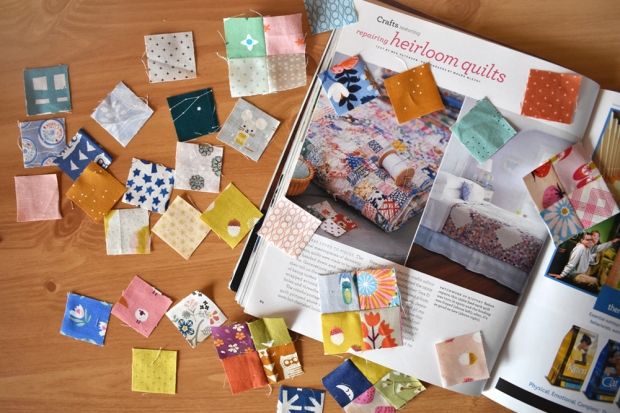
Forward: I’m making a postage stamp quilt in the style and spirit of the ones popular during the 1930s. I’ll be chronicling the process here on my blog and on Instagram!
Once upon a time, I fell madly, deeply in love with a vintage quilt I saw in a magazine. The year was 2002 and Martha Stewart Living’s August issue was given to my mom by a relative who stopped by to visit, and being a voracious reader at eight years old I read it cover to cover. I came to an article on how to repair a vintage postage stamp quilt, and the photos, paired with a story, stopped me in my tracks.
Being a massive history fan, the story accompanying the photos was every bit as good as the quilt. The article talked about how postage stamp quilts became popular during the Great Depression, using up even the tiniest scraps to make the impossibly sweet one inch squares. The fabrics usually were calicoes left over from clothing, sheets, feed sacks, and “rag bags” bought for pennies at department stores. The article walked the reader through picking new fabrics at the store (turkey red and sky blue and pale yellow were popular colors the author noted, so choose those) so new squares could be made and painstakingly appliqued over threadbare patches. I was absolutely smitten, and swore one day I’d make my own postage stamp quilt.
I’ve had a few false starts in the past seventeen years, finding the tiny squares frustrating to get lined up properly and tedious to cut. I started reading every tutorial I could find on making postage stamp quilts and giving them all a try, fiddling with the size of the squares, buying 1930s reproduction fabric only to cut it up and give up, and moved on to other projects, letting the postage stamp quilt idea keep marinating in the back of my mind.
Fast forward to earlier this year, when I found the magazine again on ebay (the original copy long gone) and coincidentally came across Amanda Jean’s post on her Lost in the Crowd Quilt and had my ah-ha moment.
In the 1930s, the postage stamp quilt was about ingenuity, a product of the “waste not, want not” attitude of a culture where every last bit counted. It wasn’t made by strip piecing, ironing a chessboard of squares to a piece of interfacing, or english paper piecing. It was made by simply cutting squares, accurately and cleanly, then stitching them together next to the radio when time allowed.
So I aim for my postage stamp quilt to exemplify a modern version of the resourceful spirit of our grandmothers, with my personality where it counts.
I’m cutting 1.5″ squares from my modern, colorful scraps, not buying any fabric specifically for this project and using a 1.5″ wide ruler that makes it fast and easy. I’m cutting the squares as often as I feel like it and chain piecing a handful of 4-patch blocks after a stressful day, usually before bed in front of an episode of Friends. It might not be exactly what our ancestors would have done in their time, but I’m pretty sure it’s what they would have done if faced with a low hobby budget, a drafty house, and a Netflix subscription today.
If you’d like more details on how I’m sewing these blocks together and getting nicely matched seams, be sure to check out Amanda Jean’s awesome tutorial that convinced me this project could be simple and fun.

Can relate, I feel like I’ve got a memory bank full of epic Martha Stewart projects I *need* to do, so great that you’ve found a way to make it happen. Looking forward to seeing those tiny squares come together!
I just started one! First quilt I’ve begun in years but I had lots of scraps. I spent one day cutting a pile of 1.5 and 2.5 squares with my rotary. Where I had too much of one color I saved strips to become borders. Then I spent an afternoon at an inherited 1950’s Singer and chain stitched pairs. I even saved some odd shaped pieces to place in just for the option to be a little crazy. Excited to be sewing again.